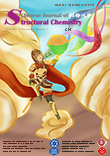
Cover Picture
Progress and
Understanding on Catalysts with Well-Defined Interface for Boosting CO2 Conversion
Binran Zhao, Yiyi Zhao, Peng Liu, Yulong Men, Xinyu Meng and Yunxiang Pan*
In the cover picture, we adapt
the ideal from "Journey to the West," one of Chinese four literary
classics. The ancient Chinese mythical character, Monkey King, holds a treasure
in his hand, which represents the catalysts with well-defined interface. CO2 is blown out from the mouth of Monkey King, then goes through the catalyst
interface, and finally is converted into high value-added chemicals like CH4,
CH3OH and CO. This well describes the focus of our paper titled “Progress
and Understanding on Catalysts with Well-defined Interface for Boosting CO2 Conversion”.
Submit a Manuscript
Cyano and Isocyano-substituted Tetraphenylethylene with AIE
Behavior and Mechanoresponsive Behavior
Qing Liu, Shusheng Yue, Zhangqiang Yan, Yongfa Xie* and Hu Cai*
Chin. J. Struct. Chem. 2022, 41, 2204075-2204082 DOI: 10.14102/j.cnki.0254-5861.2021-0049
April 8, 2022
cyano-group, isocyano-group, tetraphenylethlene (TPE), aggregation induced emission (AIE), mechanochromic
ABSTRACT
Dual-functional materials with AIE behavior and mechanoresponsive behavior have attracted considerable attention due to
their promising applications in mechano-sensors, optical storage,
solid-state optoelectric devices and bioimage systems. AIEgens
bearing tetraphenylethylene (TPE) core become elementary building
blocks in many fluorescent functional materials. In this article, cyano and isocyano-electronic withdrawing groups are incorporated with
TPE skeleton to form tetracyanophenylethylene (TPE-CN) and
tetraisocyanophenylethylene (TPE-NC). Their structures are confirmed by NMR, Mass Spectra and single crystal X-ray measurement. These two isomers reflect aggregation-induced emission (AIE) property in solution state and mechanochromic behavior in solid state.
Interestingly, their luminescent intensities, quantum yields and fluorescent lifetime in solid state have an obvious increase upon grinding. The
theoretical calculation of these two compounds clarify their difference in optical properties. The mechanochromic mechanism is also intensively
explained by powder X-ray measurements.







